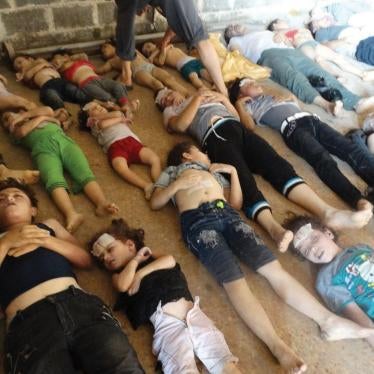This fact sheet describes the use of MAT-120 cluster munitions by Libyan government forces during the current armed conflict in Libya between forces under Libyan leader Muammar Gaddafi and opposition rebels. This is the first documented use of this type of cluster munition in combat. The MAT-120 is fired by a 120mm mortar and each projectile contains 21 dual-purpose submunitions. Spain transferred 1,055 MAT-120 cluster munitions to Libya between 2006 and 2008.
Cluster Munition Attack in Misrata
On the night of April 14, 2011, Human Rights Watch observed at least three cluster munitions explode over the el-Shawahda neighborhood of the port city of Misrata. Researchers inspected the remnants of the weapon and interviewed witnesses to two other apparent cluster munition strikes.
The area where Human Rights Watch witnessed cluster munitions strike was on the rebel side approximately one kilometer from the front line with government forces. The submunitions appear to have landed about 300 meters from Misrata hospital. Human Rights Watch could not inspect the impact sites at the time due to security concerns and has not been able to determine if civilians in Misrata have been wounded or killed by cluster munitions during or after the time of the attack.
The MAT-120 Cluster Munition
The cluster munition used in the April 14 attack was a Spanish-produced MAT-120 120mm mortar projectile, which opens in mid-air and releases 21 dual-purpose submunitions over a wide area. The submunition is considered dual-purpose because it has both antipersonnel and antimaterial effects. Upon exploding on contact with an object, each submunition disintegrates into high-velocity fragments lethal to people and releases a slug of molten metal to penetrate armored vehicles.
The MAT-120s used in Misrata were produced by the company Instalaza SA in Spain and the markings on submunitions and carrier projectile remnants indicate they were produced in 2007. In written statements made to the New York Times, Spanish officials confirmed the transfer of 1,055 MAT-120s (containing 22,155 submunitions):
One license to Lybia consisting of 5 cluster munitions for demonstration was issued in August 2006. The export took place in October 2006. There were two more licenses issued in December 2007 with a total amount of 1,050 cluster munitions. They were sent in March 2008.
All the licenses were submitted to a special scrutiny and the exports took place before the approval of a moratorium decided by the Spanish Government on the 11th July 2008 and the signature of the Oslo Convention [the Convention on Cluster Munitions] on the 3rd December 2008.
At the end of 2008, Spain destroyed its stockpile of 1,852 MAT-120 mortar projectiles, containing a total of 38,892 submunitions. Spain signed the 2008 Convention on Cluster Munitions on December 3, 2008 and ratified on June 17, 2009, becoming a state party to the convention on August 1, 2010.
Libya has not acceded to the Convention on Cluster Munitions. The current status and composition of Libya's stockpile are unknown. Libya used aerial cluster bombs, likely RBK bombs of Soviet origin, in Chad during the 1980s conflict.





